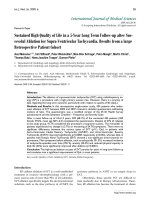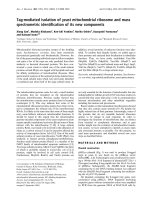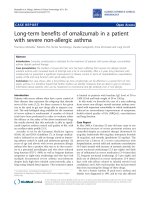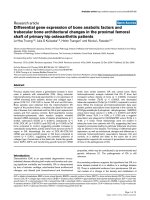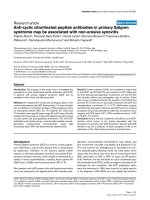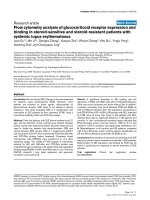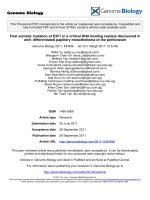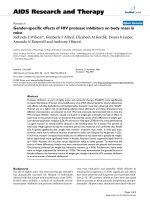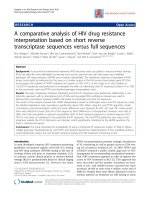Báo cáo y học: " Enhanced macrophage tropism of HIV in brain and lymphoid tissues is associated with sensitivity to the broadly neutralizing CD4 binding site antibody b12" ppsx
Bạn đang xem bản rút gọn của tài liệu. Xem và tải ngay bản đầy đủ của tài liệu tại đây (305.61 KB, 7 trang )
BioMed Central
Page 1 of 7
(page number not for citation purposes)
Retrovirology
Open Access
Short report
Enhanced macrophage tropism of HIV in brain and lymphoid tissues
is associated with sensitivity to the broadly neutralizing CD4
binding site antibody b12
Rebecca L Dunfee
1,2
, Elaine R Thomas
1,2
and Dana Gabuzda*
1,3
Address:
1
Department of Cancer Immunology and AIDS, Dana Farber Cancer Institute, Boston MA, USA,
2
Department of Pathology, Harvard
Medical School, Boston MA, USA and
3
Department of Neurology, Harvard Medical School, Boston MA, USA
Email: Rebecca L Dunfee - ; Elaine R Thomas - ;
Dana Gabuzda* -
* Corresponding author
Abstract
Macrophages in the central nervous system (CNS) and other tissues are an important cellular
reservoir for human immunodeficiency virus type 1 (HIV) infection, particularly in the later stages
of disease. Macrophage-tropic HIV strains have an enhanced capacity to enter cells expressing low
levels of CD4 through mechanisms that are not well understood. Here, we use a panel of primary
HIV envelopes from brain and lymphoid tissues to examine the relationship between neutralization
sensitivity to reagents targeting the CD4 binding site and virus entry into macrophages.
Neutralization assays using pseudotyped viruses showed an association between the capacity of
HIV to enter macrophages and increased sensitivity to the broadly neutralizing monoclonal
antibody (mAb) b12, which recognizes a conserved epitope overlapping the CD4 binding site, but
not sensitivity to soluble CD4 (sCD4) or b6, a non-neutralizing CD4 binding site mAb.
Furthermore, loss of an N-linked glycosylation site at position 386 in the V4 region of Env enhanced
macrophage tropism together with b12 sensitivity, but not neutralization by sCD4, b6, or a broadly
neutralizing AIDS patient serum. These findings suggest that exposure of the b12 epitope, rather
than exposure of the CD4 binding site per se, enhances HIV macrophage tropism, possibly by
exposing a region on the outer domain of gp120 that is initially recognized by CD4. These findings
suggest overlap between specific gp120 determinants in or near the b12 epitope and those
conferring macrophage tropism.
Background
Human immunodeficiency virus type 1 (HIV) infects tis-
sue macrophages, microglia, and other mononuclear
phagocytes, which represent an important cellular reser-
voir for viral replication and persistence in brain and
other macrophage-rich tissues (i.e., lung, gut, and bone
marrow) [1-3]. HIV entry into cells is initiated by interac-
tion between the envelope glycoprotein (Env) surface sub-
unit gp120 and CD4, which induces a conformational
change in gp120 that exposes the coreceptor binding site
[4]. The interaction of CD4-bound gp120 with a corecep-
tor, usually CCR5 or CXCR4, triggers conformational
changes in gp120 and the transmembrane subunit gp41
that enable fusion and virus entry. CCR5 is the primary
coreceptor used for infection of macrophages [4-7]. CCR5
usage is neither necessary nor sufficient for macrophage
Published: 20 July 2009
Retrovirology 2009, 6:69 doi:10.1186/1742-4690-6-69
Received: 20 April 2009
Accepted: 20 July 2009
This article is available from: />© 2009 Dunfee et al; licensee BioMed Central Ltd.
This is an Open Access article distributed under the terms of the Creative Commons Attribution License ( />),
which permits unrestricted use, distribution, and reproduction in any medium, provided the original work is properly cited.
Retrovirology 2009, 6:69 />Page 2 of 7
(page number not for citation purposes)
tropism [8], however, suggesting that determinants other
than those that specify coreceptor usage influence the
capacity of HIV to replicate in macrophages.
Macrophages express lower levels of CD4 compared to
CD4+ T-lymphocytes. Previous studies demonstrated that
HIV macrophage tropism is associated with an enhanced
capacity to use low levels of CD4 for fusion and entry [9-
14]. We previously identified amino acid variants in the
HIV Env that increase viral tropism for macrophages by
enhancing gp120-CD4 affinity (N283 in the C2 region) or
exposure of the CD4 binding site (loss of an N-linked gly-
cosylation site at position 386 in the V4 region) [9,10].
However, HIV can also acquire an enhanced ability to
enter macrophages by additional mechanisms that are not
well defined.
The HIV envelope glycoproteins are the primary target for
neutralizing antibodies in vivo [15,16]. The antibody
response to acute HIV infection develops rapidly, and
evolves concurrently with viral diversity during the course
of disease, exerting strong selection pressure on viral evo-
lution and leading to emergence of neutralization-resist-
ant HIV variants [17,18]. The ability to generate
neutralizing antibodies diminishes during disease pro-
gression, reflecting progressive loss of CD4 T-cell help and
B-cell dysfunction.
HIV isolates that replicate efficiently in macrophages and
microglia frequently exhibit increased sensitivity to neu-
tralizing antibodies [11-13,19,20]. Consistent with these
findings, a simian-human immunodeficiency virus
(SHIV) isolated from infected rhesus macaques with neu-
rological disease exhibited enhanced macrophage tropism
together with increased sensitivity to neutralizing anti-
bodies [21]. The HIV Env amino acid variant D386, which
eliminates an N-linked glycosylation site and increases
exposure of the conserved broadly neutralizing mono-
clonal antibody (mAb) b12 epitope overlapping the CD4
binding site, also enhances HIV macrophage tropism
[10,22,23]. Previous studies reported that HIV macro-
phage tropism correlates with increased neutralization
sensitivity to mAbs and other reagents that block Env-
CD4 interactions but not with sensitivity to other entry
inhibitors [22,23]. Collectively, these findings suggest
that an association between enhanced HIV entry into
macrophages and increased sensitivity to reagents target-
ing the CD4 binding site.
Here, we use a panel of viruses expressing primary HIV
Envs from brain and lymphoid tissues [9,10,14] to further
examine the association between neutralization sensitiv-
ity to reagents targeting the CD4 binding site and macro-
phage tropism. The capacity of HIV to enter macrophages
correlated with neutralization sensitivity to the CD4 bind-
ing site mAb b12 and a broadly neutralizing HIV-infected
patient serum, but not sensitivity to soluble CD4 (sCD4)
or mAb b6, another mAb that targets the CD4 binding
site. The loss of an N-linked glycosylation site at position
386 enhanced macrophage tropism together with sensi-
tivity to mAb b12, but not sensitivity to sCD4, mAb b6, or
HIV-infected patient serum. These findings suggest that
exposure of the b12 epitope overlapping the CD4 binding
site, rather than exposure of the CD4 binding site per se,
enhances HIV macrophage tropism, possibly by exposing
a region on the outer domain of gp120 that is initially rec-
ognized by CD4.
Findings
We previously demonstrated that loss of an N-linked gly-
cosylation site at position 386 in the V4 region of primary
HIV Envs increases exposure of the b12 epitope and
enhances macrophage tropism [10]. To better understand
the relationship between macrophage tropism and sensi-
tivity to reagents targeting the CD4 binding site, we used
a panel of viruses containing CCR5-tropic (R5) primary
HIV Envs cloned directly from brain and lymphoid tissues
[9,10,14] to determine neutralization sensitivity to sCD4
and mAbs b12 and b6, which recognize neutralizing and
non-neutralizing epitopes overlapping the CD4 binding
site [24], respectively, and a broadly-neutralizing HIV-
infected patient serum (Table 1). Env genes cloned into
pCR3.1 from primary virus isolates or autopsy brain and
lymphoid tissues from AIDS patients with HIV-associated
dementia (HAD) were described previously [9,14,19].
HIV luciferase reporter viruses were generated by cotrans-
fection of 293T cells with an HIV provirus with env deleted
and nef replaced by luciferase (pNL4-3env
-
luc,) and
pCR3.1-Env as described [19]. Cf2 cells [19] used as target
cells for neutralization assays were cotransfected with
pcDNA3-CD4 and pcDNA3-CCR5. HIV luciferase
reporter viruses were incubated with a range of concentra-
tions of human monoclonal Abs (mAbs), soluble CD4
(sCD4; Immunodiagnostics, Inc., Woburn, MA), or a
broadly neutralizing HIV-1 serum (HIV-1 neutralizing
serum (serum 2; [25]) obtained from L. Vujcic through
the AIDS Research and Reference Reagent Program) 1 h
prior to infection of Cf2 cells transiently expressing CD4
and CCR5. Cells were harvested 48 h post infection and
assayed for luciferase activity.
Viruses pseudotyped with HIV Envs that mediate high lev-
els of entry into macrophages had increased sensitivity to
mAb b12 and the HIV-infected patient serum compared
to viruses expressing Envs that mediate low levels of entry
in macrophages (Figure 1A, C, D, F; A and 1C, R = -0.5944,
p = 0.0093 and R = -0.5021, p = 0.034, respectively, Spear-
man correlation; 1D and 1F, p = 0.022 and 0.034, respec-
tively, Mann-Whitney test). In contrast, sensitivity to
sCD4 or the non-neutralizing mAb b6 did not correlate
Retrovirology 2009, 6:69 />Page 3 of 7
(page number not for citation purposes)
with levels of HIV entry into macrophages (Figure 1B, E, p
= 0.9141; and data not shown). Furthermore, there was
no correlation between neutralization sensitivity to mAb
b12 and neutralization sensitivity to sCD4 (p = 0.3279;
Additional file 1). These results suggest that macrophage
tropism is associated with increased sensitivity to mAb
b12, but not sensitivity to sCD4 or the non-neutralizing
CD4 binding site mAb b6. Thus, macrophage tropism was
associated with increased exposure of the b12 epitope
overlapping the CD4 binding site, rather than exposure of
the CD4 binding site per se.
Elimination of an N-linked glycan at position 386 in the
macrophage-tropic primary HIV Envs YU2 and JRFL
enhances entry into macrophages by 200% and 49%,
respectively (Table 1, Figure 2A and [10]). To determine
whether removal of the N-linked glycan at position 386
also influences sensitivity to b12 or other reagents that tar-
get the CD4 binding site, we investigated neutralization of
viruses expressing YU2 and JRFL wild-type and N386D
mutant Envs with mAbs b12 and b6, sCD4 and the
broadly neutralizing HIV-infected patient serum. The
N386D change in both YU2 and JRFL resulted in a 2-fold
increase in sensitivity to neutralization by mAb b12 com-
pared to that of the wild-type parental Envs (Table 1 and
Figure 2B). The N386D change in YU2 resulted in
increased sensitivity to sCD4, whereas the N386D change
in JRFL decreased sCD4 sensitivity compared to the wild-
type parental Envs (Table 1 and Figure 2C). YU2 and JRFL
wild-type and N386D mutant viruses had similar sensitiv-
ities to neutralization by mAb b6 and the HIV-infected
patient serum (Table 1, Figure 2D, and data not shown).
These results are consistent with our previous study in
which the reverse mutation D386N, which restored the N-
linked glycan at position 386 in the macrophage-tropic
UK1br and Macs2br13 Envs, decreased sensitivity to neu-
tralization by mAb b12 along with replication in macro-
phages [10].
Our findings demonstrate an association between the
capacity of HIV to enter macrophages (i.e., macrophage
tropism) and neutralization sensitivity to the CD4 bind-
ing site mAb b12, but not sensitivity to the non-neutraliz-
ing mAb b6 or sCD4. Furthermore, we show that loss of
an N-linked glycosylation site at position 386 in the mac-
rophage-tropic HIV YU2 and JRFL Envs enhances macro-
phage tropism along with neutralization sensitivity to
b12, but not neutralization sensitivity to sCD4, b6, or a
broadly neutralizing AIDS patient serum. These findings
suggest overlap between specific gp120 determinants in or
near the b12 epitope and those conferring macrophage
tropism.
CD4, b12, and b6 have overlapping binding sites on
gp120 [24,26]. The b12 mAb recognizes a conserved
epitope on the neutralizing face of gp120 overlapping the
CD4 binding site, while b6 recognizes a different epitope
that partially overlaps the binding sites for b12 and CD4
Table 1: Neutralization sensitivity of primary HIV-1 Envs with variable macrophage tropism to gp120 mAbs, soluble CD4, and a
broadly neutralizing HIV-infected patient serum
Patient Tissue
a
Env clone MDM entry
b
b12 IC
50
c
b6 IC
50
c
sCD4 IC
50
c
PS IC
50
c
MACS2 FL 8–12 35478 3.37 > 20 1.03 80.9
9–15 1765 1.15 > 20 0.22 76.4
LN 10–15 13001 0.99 > 20 > 20 < 50
SP 6–18 59224 10.89 > 20 > 20 < 50
MACS3 FL 12–27 13810 > 20 1.87 1.10 < 50
5 3402 > 20 6.78 0.40 < 50
LN 2 1957 > 20 > 20 3.22 < 50
20 16658 > 20 > 20 > 20 < 50
UK1 FL 2–13b 4378 0.05 > 20 5.44 < 50
SP 6–20 812689 0.03 > 20 2.39 124.2
20 35723 0.03 > 20 0.27 230.2
UK7 FL 6–24 9659 5.53 > 20 7.68 145
1–4 13207 11.37 > 20 > 20 128
isolate br34 496588 0.26 > 20 0.45 332.2
LN 7–6 5260 5.55 > 20 > 20 < 50
controls YU2 38052 5.47 > 20 1.14 72.4
YU2 N386D 114755 2.79 > 20 0.45 115.2
JRFL 215305 0.18 > 20 3.72 107.3
JRFL N386D 320642 0.09 > 20 6.05 92.7
a
FL, frontal lobe (brain); LN, lymph node; SP, spleen
b
Luciferase activity in monocyte-derived macrophages (MDM) infected with pseudotyped luciferase-expressing reporter viruses [10,14].
c
mAb (μg/ml), soluble CD4 (sCD4; μg/ml), or HIV-infected patient serum (PS; reciprocal serum dilution) concentration at which luciferase
expression was reduced by 50% compared to infection in the absence of mAb (IC
50
).
Retrovirology 2009, 6:69 />Page 4 of 7
(page number not for citation purposes)
[24]. The initial Env-CD4 interaction readily dissociates,
and conformational changes in Env induced by CD4
binding increase the stability of the Env-CD4 complex
before subsequent structural rearrangements allow core-
ceptor binding [26,27]. b12 contact occurs at the exposed
surface on the outer domain of gp120 that is initially rec-
ognized by CD4 [26]. Furthermore, b12 is the only anti-
body that targets the CD4 binding site and also recognizes
Env in the CD4-bound, stabilized conformation adopted
before coreceptor binding [26]. These observations sup-
port the idea that exposure of the b12 epitope enhances
HIV entry into macrophages, which express low levels of
CD4 compared to T-cells, possibly by exposing a region
on the outer domain of gp120 initially recognized by
CD4.
The loss of a glycosylation site at HIV Env position 386
increases exposure of the b12 epitope [10,22,28], proba-
bly due to loss of steric hindrance, and also enhances mac-
rophage tropism in a strain-dependent manner [10]. Loss
of a glycosylation site at 386 does not predict b12 sensitiv-
ity [10,22,28], however, suggesting that other Env deter-
minants influence exposure of the b12 epitope. Duenas-
Decamp et al. showed that an arginine at position 373 in
the C3 region, proximal to the CD4 binding site, increased
resistance to b12 neutralization [22]. However, the HIV
Enhanced HIV entry into macrophages is associated with sensitivity to neutralizing mAb b12 and a broadly neutralizing HIV-infected patient serumFigure 1
Enhanced HIV entry into macrophages is associated with sensitivity to neutralizing mAb b12 and a broadly
neutralizing HIV-infected patient serum. HIV luciferase reporter viruses pseudotyped with primary HIV Envs cloned
directly from brain, spleen, or lymph node tissues from AIDS patients with HAD were incubated with a range of concentra-
tions of human mAb b12 (A and D), soluble CD4 (sCD4; B and E), or HIV-1 neutralizing patient serum (PS; C and F) 1 h prior
to infection of Cf2 cells transiently expressing CD4 and CCR5. Cells were harvested 48 h post infection and assayed for luci-
ferase activity. (A, B, C) The concentrations at which luciferase expression was reduced by 50% compared to infection in the
absence of mAb (IC
50
) were calculated and plotted as a function of MDM entry [10,14]. R and p values were determined by
Spearman correlation. (D, E, F) b12, sCD4, and PS IC50s of HIV Envs with low to intermediate MDM infectivity (< median;
median = 16,658 relative luciferase units) were compared to Envs with intermediate to high MDM infectivity (> median).
Monocyte-derived macrophages (MDM) were isolated from peripheral blood mononuclear cells from healthy HIV-1-negative
donors by plastic adherence and cultured in RPMI 1640 medium supplemented with 10% FBS, and 10 ng/ml macrophage colony
stimulating factor (M-CSF) [8]. The MDM entry and sequence data were reported previously [10,14]. Env clones containing
either the N386 or D386 variant are indicated by closed and open symbols, respectively. MDM were prepared as above in 48-
well plates and infected with 2 × 10
4 3
H cpm RT units of Env pseudotyped virus stock. Cells were lysed 6 days post-infection
and assayed for luciferase activity. Significant differences between groups (p < 0.05, Mann-Whitney test) are indicated by a *.
0.01 1001010.1
b12 IC
50
(μg/ml)
MDM entry (luciferase activity)
R = -0.5944
p = 0.0093
R
2
= 0.4298
0
20
15
10
5
b12 IC
50
(μg/ml)
MDM entry
High Low
p = 0.0220
0.2598
8.460
MDM entry (luciferase activity)
sCD4 IC
50
(μg/ml)
R = -0.02655
p = 0.9141
0
20
15
10
5
MDM entry
High Low
sCD4 IC
50
(μg/ml)
1.142
6.560
0.0250.0200.0100.0050
MDM entry (luciferase activity)
PS IC
50
(serum dilution)
R = -0.5021
p = 0.0337
R
2
= 0.3022
0.025
0.020
0.015
0.010
0.005
0
PS IC
50
(serum dilution)
MDM entry
High Low
p = 0.0339
0.009
0.02
A
BC
DEF
10
3
10
4
10
5
10
6
1001010.1
10
3
10
4
10
5
10
6
6x10
5
2x10
5
4x10
5
0
0.015
Brain N386 Brain D386 Spleen N386 Spleen D386 Lymph Node N386
Retrovirology 2009, 6:69 />Page 5 of 7
(page number not for citation purposes)
Envs in the present study all have methionine or threo-
nine at position 373, and b12 neutralization did not cor-
relate with amino acid differences at this position (data
not shown). Thus, the influence of amino acid changes at
position 373 on exposure of the b12 epitope is highly
strain-dependent.
We found that a majority of macrophage-tropic HIV Envs
are sensitive to b12 neutralization. A recent study demon-
strated that early transmitted HIV variants replicate in T-
cells but have relatively low capacity to replication in
MDM [29]. HIV viruses isolated from late-stage AIDS
patients have enhanced macrophage tropism together
with increased neutralization sensitivity to b12 compared
to viruses isolated from asymptomatic HIV-infected indi-
viduals [30]. Anti-CD4 binding site antibodies are gener-
ated after HIV infection, and can be detected in most HIV-
infected individuals [31-33]. Broader and more potent
neutralizing antibody responses are often due to the pres-
ence of neutralizing antibodies targeting the CD4 binding
site [31-33]. However, only rare individuals develop
broadly neutralizing anti-CD4 binding site antibodies, so
b12-like antibodies are uncommon in HIV-infected
patients. The neutralizing activity of sera from long-term
nonprogressors is partially attributable to the presence of
antibodies that target the CD4 binding site [32,34], sug-
gesting these antibodies may play a role in controlling
viral replication in vivo. Neutralizing antibody responses
that target the b12 binding site may exert negative selec-
tion pressure against macrophage-tropic HIV variants
until the later stages of HIV disease. The brain may be a
site for emergence and persistence of neutralization-sensi-
tive macrophage-tropic HIV variants, particularly in the
setting of a weak humoral immune response [35,36].
Figure 2
0
40
15
10
5
20
35
30
25
MDM entry (luciferase activity x 10
4
)
YU2 JRFL
Env
wild-type
N386D
A
0
8
3
2
1
4
7
6
5
YU2 JRFL
Env
B
wild-type
N386D
b12 IC
50
(μg/ml)
0
8
3
2
1
4
7
6
5
YU2 JRFL
Env
C
sCD4 IC
50
(μg/ml)
wild-type
N386D
0
160
60
40
20
80
140
120
100
YU2 JRFL
Env
PS IC
50
(reciprocal serum dilution)
wild-type
N386D
D
Loss of an N-linked glycan at position 386 in primary HIV Envs enhances macrophage tropism and neutralization sensi-tivity to mAb b12Figure 2
Loss of an N-linked glycan at position 386 in primary
HIV Envs enhances macrophage tropism and neu-
tralization sensitivity to mAb b12. (A) MDM were
infected with luciferase-expressing reporter viruses express-
ing wild-type or N386D mutant Envs. Cells were lysed 6 days
post-infection and analyzed for luciferase activity. (B, C, D)
Luciferase-expressing reporter viruses expressing wild-type
or N386D mutant Envs were incubated with a range of con-
centrations of human mAb b12 (B), sCD4 (C), or a HIV-1
neutralizing patient serum (PS; D) 1 h prior to infection of
Cf2 cells transiently expressing CD4 and CCR5. Cells were
harvested 48 h post infection and assayed for luciferase activ-
ity. Data are expressed as the concentrations at which luci-
ferase expression was reduced by 50% compared to infection
in the absence of mAb (IC
50
). Error bars represent standard
deviations.
Retrovirology 2009, 6:69 />Page 6 of 7
(page number not for citation purposes)
In conclusion, macrophage-tropic HIV strains play a role
in the establishing long-lived cellular reservoirs in macro-
phage-rich tissues that include brain, lung, gut, and bone
marrow [1-3]. Furthermore, macrophages are the princi-
pal source of virus after CD4+ T cells are depleted [37]. In
this study, we demonstrate an association between HIV
macrophage tropism and neutralization sensitivity to the
CD4 binding site mAb b12. In contrast, there was no asso-
ciation with neutralization sensitivity to the non-neutral-
izing CD4 binding site mAb b6 or sCD4. These findings
suggest overlap between specific gp120 determinants that
increase exposure of the b12 epitope and those conferring
macrophage tropism. Future studies will be important to
better understand immune selection pressures that drive
HIV evolution towards variants with enhanced macro-
phage tropism, and the role of neutralizing antibodies
that target the CD4 binding site in these processes.
Competing interests
The authors declare that they have no competing interests.
Authors' contributions
R.L.D. and D.G. designed research; R.L.D. and E.R.T per-
formed research; R.L.D. and D.G. analyzed data; and
R.L.D. and D.G. wrote the paper.
Additional material
Acknowledgements
We thank Dennis Burton (Scripps) for providing the b12 and b6 antibodies.
This work was supported by NIH grant MH83588. Core facilities were sup-
ported by Harvard University Center for AIDS Research and DFCI/Har-
vard Cancer Center grants.
References
1. Gorry PR, Churchill M, Crowe SM, Cunningham AL, Gabuzda D:
Pathogenesis of macrophage tropic HIV-1. Curr HIV Res 2005,
3:53-60.
2. Pierson T, McArthur J, Siliciano RF: Reservoirs for HIV-1: mecha-
nisms for viral persistence in the presence of antiviral
immune responses and antiretroviral therapy. Annu Rev Immu-
nol 2000, 18:665-708.
3. Wang TH, Donaldson YK, Brettle RP, Bell JE, Simmonds P: Identifi-
cation of shared populations of human immunodeficiency
virus type 1 infecting microglia and tissue macrophages out-
side the central nervous system. J Virol 2001, 75:11686-11699.
4. Doms RW: Beyond receptor expression: the influence of
receptor conformation, density, and affinity in HIV-1 infec-
tion. Virology 2000, 276:229-237.
5. Berger EA, Murphy PM, Farber JM: Chemokine receptors as HIV-
1 coreceptors: roles in viral entry, tropism, and disease. Annu
Rev Immunol 1999, 17:657-700.
6. Clapham PR, McKnight A: Cell surface receptors, virus entry
and tropism of primate lentiviruses. J Gen Virol 2002,
83:1809-1829.
7. Moore JP, Kitchen SG, Pugach P, Zack JA: The CCR5 and CXCR4
coreceptors – central to understanding the transmission and
pathogenesis of human immunodeficiency virus type 1 infec-
tion. AIDS Res Hum Retroviruses 2004, 20:111-126.
8. Gorry PR, Bristol G, Zack JA, Ritola K, Swanstrom R, Birch CJ, Bell
JE, Bannert N, Crawford K, Wang H, et al.: Macrophage tropism
of human immunodeficiency virus type 1 isolates from brain
and lymphoid tissues predicts neurotropism independent of
coreceptor specificity. J Virol 2001, 75:10073-10089.
9. Dunfee RL, Thomas ER, Gorry PR, Wang J, Taylor J, Kunstman K,
Wolinsky SM, Gabuzda D: The HIV Env variant N283 enhances
macrophage tropism and is associated with brain infection
and dementia. Proc Natl Acad Sci USA 2006, 103:15160-15165.
10. Dunfee RL, Thomas ER, Wang J, Kunstman K, Wolinsky SM, Gabuzda
D: Loss of the N-linked glycosylation site at position 386 in
the HIV envelope V4 region enhances macrophage tropism
and is associated with dementia. Virology 2007,
367:222-234.
11. Martin J, LaBranche CC, Gonzalez-Scarano F: Differential CD4/
CCR5 utilization, gp120 conformation, and neutralization
sensitivity between envelopes from a microglia-adapted
human immunodeficiency virus type 1 and its parental iso-
late. J Virol 2001, 75:3568-3580.
12. Martin-Garcia J, Cao W, Varela-Rohena A, Plassmeyer ML, Gonzalez-
Scarano F: HIV-1 tropism for the central nervous system:
Brain-derived envelope glycoproteins with lower CD4
dependence and reduced sensitivity to a fusion inhibitor.
Virology 2006, 346:169-179.
13. Peters PJ, Bhattacharya J, Hibbitts S, Dittmar MT, Simmons G, Bell J,
Simmonds P, Clapham PR: Biological analysis of human immun-
odeficiency virus type 1 R5 envelopes amplified from brain
and lymph node tissues of AIDS patients with neuropathol-
ogy reveals two distinct tropism phenotypes and identifies
envelopes in the brain that confer an enhanced tropism and
fusigenicity for macrophages. J Virol 2004, 78:6915-6926.
14. Thomas ER, Dunfee RL, Stanton J, Bogdan D, Taylor J, Kunstman K,
Bell JE, Wolinsky SM, Gabuzda D: Macrophage entry mediated
by HIV Envs from brain and lymphoid tissues is determined
by the capacity to use low CD4 levels and overall efficiency
of fusion. Virology 2007, 360:105-119.
15. Burton DR, Desrosiers RC, Doms RW, Koff WC, Kwong PD, Moore
JP, Nabel GJ, Sodroski J, Wilson IA, Wyatt RT: HIV vaccine design
and the neutralizing antibody problem. Nat Immunol 2004,
5:233-236.
16. Pantophlet R, Burton DR: GP120: target for neutralizing HIV-1
antibodies. Annu Rev Immunol 2006, 24:739-769.
17. Richman DD, Wrin T, Little SJ, Petropoulos CJ: Rapid evolution of
the neutralizing antibody response to HIV type 1 infection.
Proc Natl Acad Sci USA 2003, 100:4144-4149.
18. Wei X, Decker JM, Wang S, Hui H, Kappes JC, Wu X, Salazar-
Gonzalez JF, Salazar MG, Kilby JM, Saag MS, et al.: Antibody neutral-
ization and escape by HIV-1. Nature 2003, 422:307-312.
19. Gorry PR, Taylor J, Holm GH, Mehle A, Morgan T, Cayabyab M, Far-
zan M, Wang H, Bell JE, Kunstman K, et al.: Increased CCR5 affinity
and reduced CCR5/CD4 dependence of a neurovirulent pri-
mary human immunodeficiency virus type 1 isolate. J Virol
2002,
76:6277-6292.
20. Van Marle G, Rourke SB, Zhang K, Silva C, Ethier J, Gill MJ, Power C:
HIV dementia patients exhibit reduced viral neutralization
and increased envelope sequence diversity in blood and
brain. Aids 2002, 16:1905-1914.
Additional file 1
Supplementary Figure. HIV Env neutralization sensitivity to mAb b12
does not correlate neutralization sensitivity to sCD4. HIV luciferase
reporter viruses were incubated with a range of concentrations of human
mAb b12 or sCD4 1 h prior to infection of Cf2 cells transiently expressing
CD4 and CCR5. Cells were harvested 48 h post infection and assayed for
luciferase activity. Data are expressed as the concentrations at which luci-
ferase expression was reduced by 50% compared to infection in the
absence of mAb or sCD4 (IC
50
). (A) sCD4 IC
50
s were plotted as a func-
tion of b12 IC
50
s. R and p values, Spearman correlation. (B) sCD4 IC
50
s
of HIV Envs with low to intermediate b12 sensitivity (< median; median
= 3.374
μ
g/ml) were compared to Envs with intermediate to high b12
sensitivity (> median). p values, Mann-Whitney test.
Click here for file
[ />4690-6-69-S1.pdf]
Publish with BioMed Central and every
scientist can read your work free of charge
"BioMed Central will be the most significant development for
disseminating the results of biomedical research in our lifetime."
Sir Paul Nurse, Cancer Research UK
Your research papers will be:
available free of charge to the entire biomedical community
peer reviewed and published immediately upon acceptance
cited in PubMed and archived on PubMed Central
yours — you keep the copyright
Submit your manuscript here:
/>BioMedcentral
Retrovirology 2009, 6:69 />Page 7 of 7
(page number not for citation purposes)
21. Song B, Cayabyab M, Phan N, Wang L, Axthelm MK, Letvin NL,
Sodroski JG: Neutralization sensitivity of a simian-human
immunodeficiency virus (SHIV-HXBc2P 3.2N) isolated from
an infected rhesus macaque with neurological disease. Virol-
ogy 2004, 322:168-181.
22. Duenas-Decamp MJ, Peters P, Burton D, Clapham PR: Natural
resistance of human immunodeficiency virus type 1 to the
CD4bs antibody b12 conferred by a glycan and an arginine
residue close to the CD4 binding loop. J Virol 2008,
82:5807-5814.
23. Peters PJ, Duenas-Decamp MJ, Sullivan WM, Brown R, Ankghuambom
C, Luzuriaga K, Robinson J, Burton DR, Bell J, Simmonds P, et al.: Var-
iation in HIV-1 R5 macrophage-tropism correlates with sen-
sitivity to reagents that block envelope: CD4 interactions
but not with sensitivity to other entry inhibitors. Retrovirology
2008, 5:5.
24. Pantophlet R, Ollmann Saphire E, Poignard P, Parren PW, Wilson IA,
Burton DR: Fine mapping of the interaction of neutralizing
and nonneutralizing monoclonal antibodies with the CD4
binding site of human immunodeficiency virus type 1 gp120.
J Virol 2003, 77:642-658.
25. Vujcic LK, Quinnan GV Jr: Preparation and characterization of
human HIV type 1 neutralizing reference sera. AIDS Res Hum
Retroviruses 1995, 11:783-787.
26. Zhou T, Xu L, Dey B, Hessell AJ, Van Ryk D, Xiang SH, Yang X, Zhang
MY, Zwick MB, Arthos J, et al.: Structural definition of a con-
served neutralization epitope on HIV-1 gp120. Nature 2007,
445:732-737.
27. Chang MI, Panorchan P, Dobrowsky TM, Tseng Y, Wirtz D: Single-
molecule analysis of human immunodeficiency virus type 1
gp120-receptor interactions in living cells. J Virol 2005,
79:14748-14755.
28. Sanders RW, van Anken E, Nabatov AA, Liscaljet IM, Bontjer I, Eggink
D, Melchers M, Busser E, Dankers MM, Groot F, et al.: The carbo-
hydrate at asparagine 386 on HIV-1 gp120 is not essential for
protein folding and function but is involved in immune eva-
sion. Retrovirology 2008, 5:10.
29. Salazar-Gonzalez JF, Salazar MG, Keele BF, Learn GH, Giorgi EE, Li H,
Decker JM, Wang S, Baalwa J, Kraus MH, et al.: Genetic identity,
biological phenotype, and evolutionary pathways of trans-
mitted/founder viruses in acute and early HIV-1 infection. J
Exp Med 2009,
206:1273-1289.
30. Gray L, Sterjovski J, Churchill M, Ellery P, Nasr N, Lewin SR, Crowe
SM, Wesselingh SL, Cunningham AL, Gorry PR: Uncoupling core-
ceptor usage of human immunodeficiency virus type 1 (HIV-
1) from macrophage tropism reveals biological properties of
CCR5-restricted HIV-1 isolates from patients with acquired
immunodeficiency syndrome. Virology 2005, 337:384-398.
31. Binley JM, Lybarger EA, Crooks ET, Seaman MS, Gray E, Davis KL,
Decker JM, Wycuff D, Harris L, Hawkins N, et al.: Profiling the spe-
cificity of neutralizing antibodies in a large panel of plasmas
from patients chronically infected with human immunodefi-
ciency virus type 1 subtypes B and C. J Virol 2008,
82:11651-11668.
32. Li Y, Migueles SA, Welcher B, Svehla K, Phogat A, Louder MK, Wu X,
Shaw GM, Connors M, Wyatt RT, Mascola JR: Broad HIV-1 neu-
tralization mediated by CD4-binding site antibodies. Nat Med
2007, 13:1032-1034.
33. Sather DN, Armann J, Ching LK, Mavrantoni A, Sellhorn G, Caldwell
Z, Yu X, Wood B, Self S, Kalams S, Stamatatos L: Factors associ-
ated with the development of cross-reactive neutralizing
antibodies during human immunodeficiency virus type 1
infection. J Virol 2009, 83:757-769.
34. Li Y, Svehla K, Louder MK, Wycuff D, Phogat S, Tang M, Migueles SA,
Wu X, Phogat A, Shaw GM, et al.: Analysis of neutralization spe-
cificities in polyclonal sera derived from human immunode-
ficiency virus type 1-infected individuals. J Virol 2009,
83:1045-1059.
35. Kuwata T, Byrum R, Whitted S, Goeken R, Buckler-White A, Plishka
R, Iyengar R, Hirsch VM: A rapid progressor-specific variant
clone of simian immunodeficiency virus replicates efficiently
in vivo only in the absence of immune responses. J Virol 2007,
81:8891-8904.
36. O'Neil SP, Suwyn C, Anderson DC, Niedziela G, Bradley J, Novembre
FJ, Herndon JG, McClure HM: Correlation of acute humoral
response with brain virus burden and survival time in pig-
tailed macaques infected with the neurovirulent simian
immunodeficiency virus SIVsmmFGb. Am J Pathol 2004,
164:1157-1172.
37. Igarashi T, Brown CR, Endo Y, Buckler-White A, Plishka R, Bischof-
berger N, Hirsch V, Martin MA: Macrophage are the principal
reservoir and sustain high virus loads in rhesus macaques
after the depletion of CD4+ T cells by a highly pathogenic
simian immunodeficiency virus/HIV type 1 chimera (SHIV):
Implications for HIV-1 infections of humans. Proc Natl Acad Sci
USA 2001, 98:658-663.
